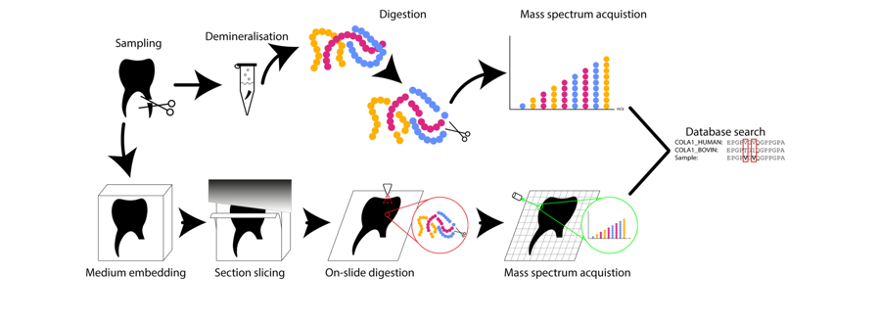Leiden University
Source - https://www.universiteitleiden.nl/en/news/2023/02/proteins-are-not-distributed-equally-in-ancient-teeth
 Schematic overview of the workflow in this study. A subsample was taken from each tooth, from which proteins were extracted and analysed using LC–MS/MS. The remainder of the whole tooth was sectioned and analysed using MALDI-MSI. The peaks selected for MSI visualisation were based on peptides identified by LC–MS/MS analysis [Color figure can be viewed at wileyonlinelibrary.com]
Schematic overview of the workflow in this study. A subsample was taken from each tooth, from which proteins were extracted and analysed using LC–MS/MS. The remainder of the whole tooth was sectioned and analysed using MALDI-MSI. The peaks selected for MSI visualisation were based on peptides identified by LC–MS/MS analysis [Color figure can be viewed at wileyonlinelibrary.com]
In a study led by Leiden alumnus Jan Dekker, based on his research master’s thesis, he applied Mass Spectrometry Imaging to archaeological human teeth. The research shows that there are large differences in the intensity of proteins across the teeth, opening new avenues of investigation.
Protein analysis
The analysis of proteins preserved in fossil bones and teeth has boomed and it is now possible to tell the species or even the sex of an individual from a very small bone fragment. Yet, protein analysis usually requires sampling the original bone which is problematic with archaeological bones that are rare and fragile. Bones and teeth are usually sampled with the assumption that proteins are equally distributed in the sample, but there has been no research on protein distribution within archaeological remains.
In a collaborative study between the University of York and Leiden University, this assumption has been disproven. The researchers, led by Jan Dekker, applied Mass Spectrometry Imaging (MSI) for the first time to archaeological human teeth to investigate the distribution of proteins across the teeth. This led to the detection of large differences in the intensity of proteins across the inside of the teeth. Additionally, the distribution of different proteins within the same tooth appears similar.
New insights
This pilot study represents the first step in understanding how proteins are distributed within teeth and adds a spatial dimension to the study of proteins in archaeological remains. This knowledge will improve our sampling techniques by selecting areas with high protein intensity. Additionally, spatial differences in protein intensity in tissues that grow incrementally and do not remodel, like teeth, might inform us about the life history of these individuals.
Spatial analysis of the ancient proteome of archeological teeth using mass spectrometry imaging - Joannes Dekker, Tony Larson, Jordan Tzvetkov, Virginia L. Harvey, Adam Dowle, Richard Hagan, Paul Genever, Sarah Schrader, Marie Soressi, Jessica Hendy https://analyticalsciencejournals.onlinelibrary.wiley.com/doi/10.1002/rcm.9486